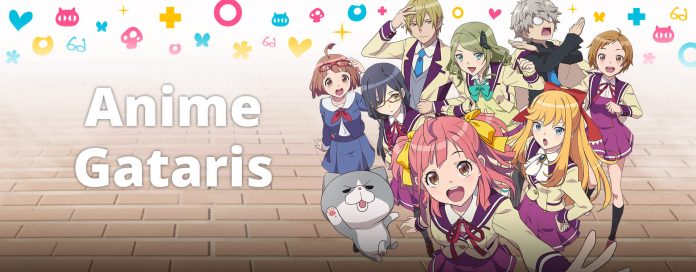Anime-Gataris tries to do a lot of bold things and is enjoyable for the most part. But I’m not sure if everything hits the mark, and I wonder if others feel the same. You’d think an anime series that would be all about how fans love anime would be a smash hit. However, I did find myself wondering if the series tried to do a little too much. I did not have any knowledge of the first series (nor did I know there was one), so I went into Anime-Gataris with an open mind to see if this series would entertain me. However, it was more mediocre than I’d like and faltered toward the end.
You…LIKE ANIME??? (via Anime-Gataris) pic.twitter.com/qNiPK3lp8G
— Crunchyroll (@Crunchyroll) April 27, 2018
Anime-Gataris follows the exploits of Minoa Asagaya, who isn’t involved with anything at school. During class, she recalls an anime she watched in her youth and how much she enjoyed it. Her classmate Arisu Kamiigusa overhears the conversation and pulls Minoa aside so that they can talk about anime (Arisu hid the fact she’s a huge fan). Not being a die-hard fan, Minoa is captivated by Arisu’s enthusiasm and the two co-found an anime club. They recruit more members and begin to discuss all things anime. Surprisingly, the student council will stop at nothing to disband the club, and there seems to be some secret hidden within the walls of the clubroom. So Minoa and her friends try to keep the spirit of anime alive at their school.
I was surprised by how informative the series was. Whenever the club members would discuss it, I found myself most interested in the in-depth analysis of specific topics. I long to have discussions like these in my personal life, so seeing it play out in an anime was rewarding. For me, Anime-Gataris’ strength is when different topics about anime are discussed. It was fun watching Minoa learn all the tricks of the trade, whether it’d be about the medium or how anime is made. We learn about the production committee, costs, deadlines, and a lot of other neat tidbits that I’m sure the dub actors got a kick out of reciting. And it doesn’t just stop at these topics. We also learn about the different types of source materials that are used to create an anime (manga, light novels, etc.). Plus, how to survive a convention, and even how tough it can be to coordinate cosplaying. I found it fascinating how much information was discussed, and yet it was still easy to follow.
An anime about anime! 💜
Own Anime-Gataris on Blu-ray, DVD & Digital 12/11: https://t.co/eUQnhFCH5C pic.twitter.com/4nS7AavhxH
— Funimation (@Funimation) November 21, 2018
Given how obsessed the main cast is about anime, you can expect a ton of anime references to be thrown into the series. Whether it be about television series or manga, anything mentioned among the anime fandom was dragged into this anime. And what made it fun was how no actual series name was ever mentioned. So the writers had to come up with clever names for the characters that made it obvious what series they were discussing. I got a kick out of the new name for Re:Zero becoming Ru:Zero, considering how big that anime was when it debuted in Japan. Plus, anime series like March Comes in Like a Lion, Gurren Lagann, and many others were mentioned, giving me a few laughs. Plus adding references about ridiculously long titles for light novels and tropes in different anime genres gave this series a nice added touch of realism for me.
This 4th wall bit in Anime Gataris had me dying for a 10 minutes straight. It caught me so off guard. pic.twitter.com/ZNph7NGk1o
— NinTwinDo (@xxNinTwinDoxx) September 26, 2019
I’m sure the English cast had a blast recording this series. Not only did they get to talk about a topic they know and love, but they also got to “bad act” as the students dubbed their own anime series. It must have been a lot of fun to record, and certainly gives those on the outside a look at what dubbing an anime is like. It was legitimately funny and a huge storyline that I enjoyed. Seeing how happy the main cast was in making their own anime was the highlight of my viewing and it would have been a nice way to wrap the series up. Sadly, that wasn’t the case (more on that later), but seeing what the main characters were able to accomplish together was satisfying.
And while the characters themselves were hit or miss with me, Kai Musashisakai tipped the scales, becoming more memorable than I expected, making the cast of Anime-Gataris generally favorable for me. He had his annoying moments, but he never lost touch with reality, quickly becoming an endearing character throughout the series. When tough times hit, he dropped his Chunibyo persona to become a reliable member, which I loved. Seeing him become an amazing friend to Minoa is something I’ll never forget. Plus, he had some great lines that had me dying of laughter. He was the complete package, giving fans someone to look forward to seeing, as well as being highly relatable. Thankfully I also found characters like Arisu Kamiigusa, Miko Kouenji, and Erika Aoyama to be enjoyable to follow as well.
Today on THIS WEEK IN ANIME, @Liuwdere and @LossThief get into how Anime-Gataris does comedy about anime fans justice. https://t.co/zPWrNXyIZ2 pic.twitter.com/t6LW1ub4ID
— Jacob Chapman (@weebservations) November 14, 2017
Sadly, the art style wasn’t to my liking. I didn’t think the characters looked all that great, and there moments of odd fanservice involving Yui Obata practicing running. It wasn’t necessarily out of place; we have a few moments of fanservice involving the main cast (bunny girl suits, changing into cosplay). But the fanservice was heavily sided toward Yui, and I’m not sure why. She wasn’t a club member and would only show up off an on. She didn’t give as lasting an impression as the actual club members did. The series ends with a fanservice shot of Yui as she drinks from a faucet after practice. Why? I’m still confused by that choice. And maybe I’d feel differently if the art style of the series was more to my liking. Instead, since it wasn’t a favorite of mine, the fanservice parts brought the show down a peg.
I also didn’t fully enjoy where the story went at the end. At episode 10 it took such a hard left turn that it was tough for me to maintain my interest. I understand that this is an anime about anime, but I enjoyed it more while watching the group discuss the medium. If Anime-Gataris wanted to do something different, I’d like it if the main cast had to overcome a huge obstacle in which anime helps them succeed. Something along the lines of seeing how believing in yourself or friendship can help in dark situations. Taking on the student council was enough drama for me, and the series didn’t need to take Minoa into the anime world to make a ridiculous plotline. It even got to a dark point with Minoa questioning her sanity, as if she was going crazy noticing all of the weirdness going on. If Anime-Gataris wanted to have a whacky storyline, I’d rather it stay dark with Minoa questioning her perception of what is real and what isn’t. Instead, it was used in a more humorous tone. The strength of the series is when things are normal, and the topic of anime is discussed, not when anime comes to life.
The English cast was somewhat inconsistent. I enjoyed Alexander Saab’s performance at Kai Musashisakai (who was my favorite character). He was able to nail the exuberant screaming and monologues in a way that made Kai seem more real. Felecia Angelle sounded great as Erika and performed her role on all cylinders. She got the knowledgeable, yet not as crazy, anime fan down pat (which I found enjoyable). And while there were other notable performances, I found these two to stand out the most for me.
This girl is literally me at times; you'll see why! I'm Minoa Asagaya in the @FUNimation dub of #AnimeGataris, directed by @DaveTrosko! 💖💛💙 pic.twitter.com/LvCdlSG0JL
— Dawn M. Bennett = Aigis 🔫 (@DawnMBennettVA) October 27, 2017
https://twitter.com/alisonviktorin/status/924037723467538433?s=20
So I just found a plushie of my character Yui, from Anime Gataris and long story short I bought it.
This is the first character I've ever played that's had a plushie. o_o pic.twitter.com/dhUv3dQLBQ
— 🎙️𝕂𝕣𝕚𝕤𝕥𝕖𝕟 𝕄𝕔𝔾𝕦𝕚𝕣𝕖 🎨 (@KrisComics) April 15, 2019
Humbled to announce that I'll be voicing Aurora "Kouki" Nakano in the @FUNimation dub of #AnimeGataris! Thx for having me @DaveTrosko pic.twitter.com/H2ybHRtbeP
— Jordan Dash Cruz 🔜 SacAnime Roseville 2024 (@DashCruzVA) October 27, 2017
Anime-Gataris comes in the standard Blu-ray case with a cardboard slipcover. However, FUNimation didn’t provide much in the form of extras. Simply textless opening and closing songs were added. I was hoping that there would be more things included (a commentary of some sorts).
I’m conflicted about Anime-Gataris. On the surface, it didn’t look as pleasing as I’d like and had characters that I either enjoyed or didn’t. The story goes into a weird place turning full-blown anime at the end. However, I loved hearing the discussions about anime and was reminded of the many conversations I’ve had with friends. So where does that leave Anime-Gataris? I guess somewhere in the middle. I’m sure there will be those who find it fun and can’t wait to get their hands on the property. Or there might be some who feel this series is mediocre in a vast sea of content. It depends on how much meta you can take and how much the references hit or miss with you. I wouldn’t call it a masterpiece, but overall it’s fun.
Rating: 6.5/10
Pros: Relatable conversations about anime; informative discussions about anime; funny gags and references throughout; the series becoming self-aware was fun at points; Kai Musashisakai’s Swiss bank account.
Cons: Art style wasn’t my favorite; hit or miss characters; the story takes a dramatic left turn.
C.J Maffris is the Editor-in-Chief at Toonami Faithful. Feel free to follow C.J on Twitter @SeaJayMaffris

